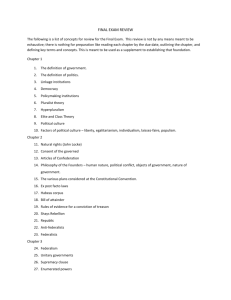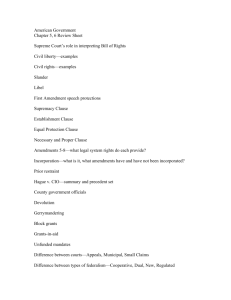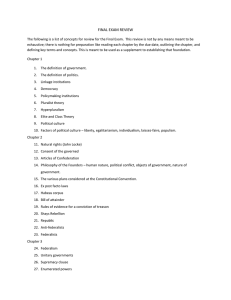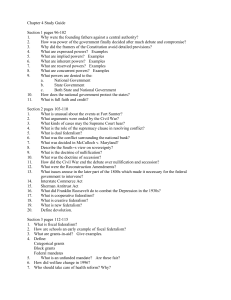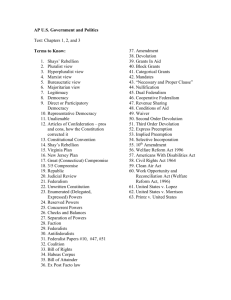Powerpoint - Lewiston Independent School District #1
advertisement
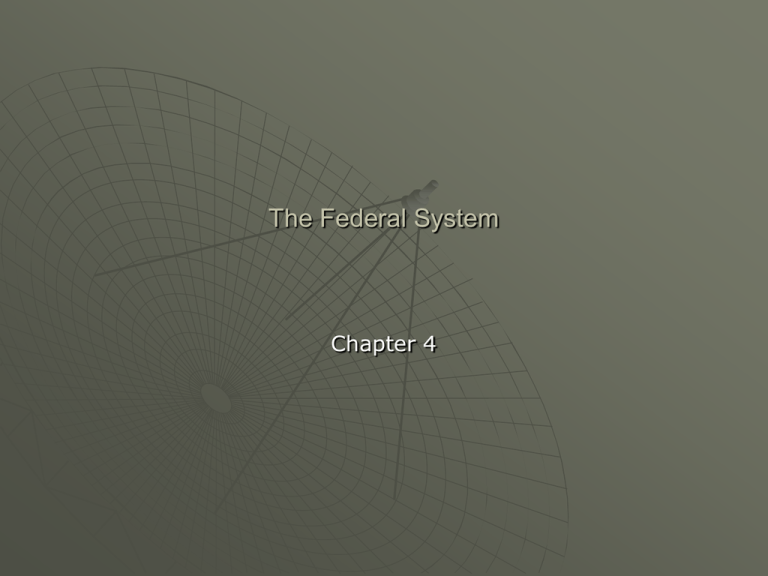
The Federal System Chapter 4 The Federal System I. Federalism • A. Power is divided between a central government and constituent governments. 1. both exercise direct authority 2. Two types: • Fed to state • State to county • B. National Powers: 1. Delegated powers: granted in constitution. • a. Expressed powers • b. Implied powers: Elastic Clause – tied to meeting expressed. • c. Inherent Powers 2. Exclusive powers: only feds 3. Supremacy Clause 4. Denied Powers: Specific prohibitions 5. Concurrent Powers: both national and state governments share (tax, courts, laws). EXPRESSED POWERS borrow money regulate commerce with foreign nations, and among the several states, and with the Indian tribes establish a uniform rule of naturalization uniform laws on the subject of bankruptcies coin money, regulate the value thereof, and of foreign coin, and fix the standard of weights and measures provide for the punishment of counterfeiting establish post offices and post roads promote the progress of science and useful arts, securing authors and inventors the exclusive right to their respective writings and discoveries constitute tribunals inferior to the Supreme Court define and punish piracies and felonies committed on the high seas, and offenses against the law of nations declare war, grant letters of marque and reprisal, and make rules concerning captures on land and water raise and support armies, but no appropriation of money to that use shall be for a longer term than two years provide and maintain a navy make rules for the government and regulation of the land and naval forces provide for calling forth the militia to execute the laws of the union, suppress insurrections and repel invasions provide for organizing, arming, and disciplining, the militia, and for governing such part of them as may be employed in the service of the United States, reserving to the states respectively, the appointment of the officers, and the authority of training the militia according to the discipline prescribed by Congress Rule D.C. necessary and proper • C. State Powers: Reserved Powers th 1. 10 Amendment: • "The power not delegated to the United States by the Constitution not prohibited to it by the States, are reserved to the States or to the people." 2. Power to determine the qualifications for voting most important 3. Three categories of reserved powers: • a. Public education • b. Police powers • c. Right to regulate commerce within a state, intrastate commerce. II. Relationships of Federalism • A. Vertical Federalism: relationship national to state 1. National government provides for states 2. Safety Leadership States Participate Conduct elections • B. Horizontal Federalism: state to state. 1."Full Faith and Credit" • a. accept other states' public acts, records, and judicial proceedings. (divorce) 2."Privileges and Immunities." same rights (property) 3. Extradition (optional) III. Changing Federalism • A. National Supremacy versus States' Rights 1. Nation-centered view • a. Federalists 2. State-centered view • a. Anti-Federalists • b. Nullification theory: States declare acts of Congress unconstitutional 3. Ended by succession and Civil War • B. Dual Federalism (1865-1933) 1. Distinct spheres of national and state authority • C. Cooperative Federalism (1933-1968) 1. National expansion • a. Liberal application of interstate commerce clause 2. Grants-in-aid • a. Explosion in national funds to states and cities 1. First New Deal 2. Second New Deal 3. Great Society • D. New Federalism (1968-present) 1. Generalized grants 2. Erosion of State Powers IV. Federalism's power struggle • A. National Regulation 1. Direct orders • a. States must comply 2. Preemption: takes power away from local governments (cable regulation) 3. Partial preemption: minimum standards (Clean Air Act) • B. Grants-in-aid: grants restricted unless conditions are met (speed limits) • A. Types of Grants 1. categorical: specific purpose 2. block: broad areas; less restrictive



